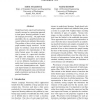Free Online Productivity Tools
i2Speak
i2Symbol
i2OCR
iTex2Img
iWeb2Print
iWeb2Shot
i2Type
iPdf2Split
iPdf2Merge
i2Bopomofo
i2Arabic
i2Style
i2Image
i2PDF
iLatex2Rtf
Sci2ools
NAACL
2007
2007
Data-Driven Graph Construction for Semi-Supervised Graph-Based Learning in NLP
Graph-based semi-supervised learning has recently emerged as a promising approach to data-sparse learning problems in natural language processing. All graph-based algorithms rely on a graph that jointly represents labeled and unlabeled data points. The problem of how to best construct this graph remains largely unsolved. In this paper we introduce a data-driven method that optimizes the representation of the initial feature space for graph construction by means of a supervised classifier. We apply this technique in the framework of label propagation and evaluate it on two different classification tasks, a multi-class lexicon acquisition task and a word sense disambiguation task. Significant improvements are demonstrated over both label propagation using conventional graph construction and state-of-the-art supervised classifiers.
Computational Linguistics | Graph Construction | Graph-based Semi-supervised Learning | NAACL 2007 | Supervised Classifiers |
| Added | 30 Oct 2010 |
| Updated | 30 Oct 2010 |
| Type | Conference |
| Year | 2007 |
| Where | NAACL |
| Authors | Andrei Alexandrescu, Katrin Kirchhoff |
Comments (0)

